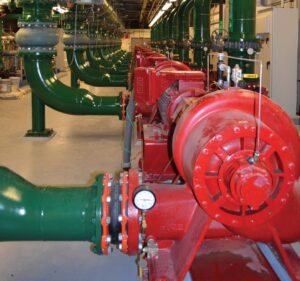Engineers must evaluate safety, costs, efficiencyof VRF versus hydronics
With heating and cooling among the largest costs in commercial buildings, HVAC system selection is an important component in both new construction and retrofit projects to keep costs in line and realize energy-efficiency targets.
Hydronic systems provide water-based heating and cooling, a proven, cost-effective and sustainable medium.
Rising energy costs and a movement toward sustainability are driving changes in the commercial HVAC market. As design engineers, building owners and mechanical contractors focus on increasing comfort and maintaining air quality while reducing overall energy consumption, the technology and components of HVAC systems are constantly being re-evaluated.
With heating and cooling among the largest costs for most buildings, building owners are intent on findingnew and effective approaches for new buildings and improving performance of existing facilities. And as the industry continues the shift to sustainable building practices that maximize building performance while minimizing environmental impact, the type of HVAC system is an important factor in realizing energy efficiency
targets. Additional factors such as safety and code compliance, and costs related to serviceability and life cycle are among those that also must be considered in evaluating HVAC systems.
Two heating and cooling methods often compared interms of energy consumption and system performance are hydronic systems and variable refrigerant flow(VRF) systems.
Hydronic systems as a room comfort technology have been in use in some form for centuries. Today’s hydronic systems provide water-based heating and cooling through pipes, ductwork and other components such as pumps, drives, controls, heat exchangers and valves.
VRF systems use refrigerant as the primary heating/ cooling medium, comprised of a main compressor unit connected through refrigerant lines to multiple indoor
cassette units that can be individually controlled. They were developed in the 1980s in Europe and Asia and introduced in the United States about a decade ago.
While each has its place in commercial building HVAC systems, specifying engineers must be diligent in their review of project parameters and the applicable safety codes of ASHRAE Standards 15 and 34 to ensure they are making suitable selections. A closer examination of the key areas of differentiation between hydronic and VRF can also assist system designers in the process.

System capacity
When specifying a system, it’s important to consider not just building size, but also the size of the HVAC system itself. Hydronic systems are better suited to handle buildings requiring 50 to 100 tons of cooling capacity or more. Hydronic systems also have the capacity to pump water efficiently over very longdistances, such as a college campus or a high-rise officetower.
In contrast, system efficiency in VRF goes down based on the length of refrigerant pipe runs. ASHRAEStandards 15 and 34 define specific refrigerant concentration limits based on pounds of refrigerant perthousand cubic feet of interior volume beyond whichacute toxicity is expected. Typically, refrigerant chargein a VRF system is 4 to 6 pounds of refrigerant per tonof cooling. To adhere to ASHRAE 15 requirements, theVRF system may need to be broken down into smallerrefrigerant circuits, thus compromising the benefits of diverting loads.
VRF systems are generally limited to buildings fewer than 10 stories because the length of piping runs must be limited and zoned properly in order to carry refrigerants and oil through the building in accordance with manufacturer guidelines. Long lengths of piping can jeopardize performance of the unit ranging from oil or refrigerant accumulation in the piping to de-rated efficiencies.
Care must be taken to ensure the refrigerant piping is not installed down hallways or in a large open office floor plan, both of which are considered meansof egress per standards set by ASHRAE and the International Association of Plumbing and Mechanical Officials (IAPMO). Even with ceiling-mounted firesuppression and sprinkler systems, these areas are still considered as the means of egress.
Refrigerants in question
While it’s possible for leaks to develop in both hydronic and VRF systems, a leak in a VRF system can be deadly. VRF refrigerant leaks can’t be detected by either sight or smell, making them hard to find and repair. Inspaces with minimal ventilation, large concentrations of refrigerant gas in the air can put people at risk of asphyxiation.
Hydronic systems with cooling units also require refrigerant to operate, but the average system uses 66 to 75 percent less refrigerant than a VRF system of the same size, according to the Hydronics Industry Alliance. Hydronic systems are not exempt from the ASHRAE and IAPMO codes that govern the HVAC and plumbing industries, however, the refrigerant in a hydronics system is typically contained within a mechanical room, which, by code, is required to have the proper ventilation to deal with a potential leak.
Aside from the small amount of refrigerant associated with cooling units in a hydronic system, the water running through the system and in its pipes over the life of the system poses no safety or environmental risks.
The same cannot be said for VRF refrigerants. The Environmental Protection Agency issued major changes to the Section 608 rules of the Clean Air Act, which govern the handling, use and sale of refrigerants. Most notable is the regulation banning the use of hydrofluorocarbons such as R-410A in new chillers(air-cooled, water-cooled, scroll, screw and centrifugal), rooftop units and VRF systems beginning in 2024.
Under the updated rules, the EPA expanded the refrigerant management program, extending the regulations to non-ozone-depleting substitutes such as hydrofluorocarbons. This action lowers the allowable leak rate for comfort cooling and refrigeration appliances. It also incorporates industry best practices, such as verifying repairs and conducting annual leak inspections for systems that have lost a small amount of their refrigerant charge.
Service protocols
Proprietary VRF systems require specialized technicians for installation and maintenance — which can drive up costs — compared to hydronic water systems designed with universal components that can be installed and serviced by any HVAC service technician. Components in a hydronic system are factory made and tested, reducing rate of failure after installation.
Since VRF piping requires brazing and soldering onsite, the quality of the installation depends on the level of expertise of the installer. Installers also must be qualified to work with refrigerants under extremelyhigh pressure and be knowledgeable about leak detection and ventilation requirements per IAPMO and the International Code Council, which have adopted ASHRAE 15 Standards.
In addition, each VRF manufacturer has a different protocol, which further reduces the pool of qualifiedtechnicians for installation and maintenance. Improper installation and maintenance can cause premature failure of VRF systems.
With hydronic systems, component manufacturers can be changed and new technologies installed without impacting the other system components.
Cost differences
The initial cost of a hydronic system is generally lower, and systems offer a much wider range of flexibilityfor components, operation and maintenance, both in terms of parts and service. Advanced systems include application of technologies such as integrated and single-pipe systems that dramatically reduce piping and costs, and pumps equipped with variable speed drives that increase energy efficiency.
VRF systems generally have a shorter life expectancy than hydronic systems. Hydronic systems have been known to last 20 to 25 years, while VRF systems could need replacing as soon as 10 or 15 years after installation. The compressor in a VRF system is forced to work harder during heating cycles, reducing the life of the compressor.
At lower temperatures, hydronic systems are more reliable than VRF systems. That’s because a VRF system may require a supplementary heat source in cold climates, such as electric heat, which could negate the energy efficiency of the system. Without anotherheat source, the VRF compressor can be set to run at maximum capacity for the morning warm-up, but that takes more electricity, potentially negating any efficiencybenefits, including reduced energy costs.
VRF system can provide simultaneous heating and cooling, and can recover heat from one zone and use it in another. This is effective in buildings with multiple temperature zones, such as a hotel. However, a VRF system does not have the capability of storing energy. Water in a hydronic system can draw the heat or chill out of a room and carry that energy back to the system for storage and later use, reducing energy consumption and costs.
Conclusion
These and other considerations have relevancy for building owners, architects, design engineers and all those who have a stake in commercial building HVAC system design, installation, operation and maintenance. Those who influence system selections must be diligentin their analysis to ensure systems are code compliant,energy efficient and adaptable to future energy sources.The most efficient systems in terms of cost, performanceand efficiency will be in demand to help meet energygoals and keep building costs in line.
Kyle DelPiano is the Business Development Manager – Commercial Buildings Services market for Xylem. He holds a bachelor of science degree in polymer and fiber engineering from Auburn University. He has nearly10 years of experience in the HVAC industry in a varietyof sales, training and marketing roles. In addition, he is an active HIA-C and ASHRAE chapter member and isLEED AP certified.
Xylem Inc.
8200 N. Austin Avenue
Morton Grove, Illinois 60053
Phone: (847) 966-3700 Fax: (847) 965-8379
www.xyleminc.com/bellgossett

